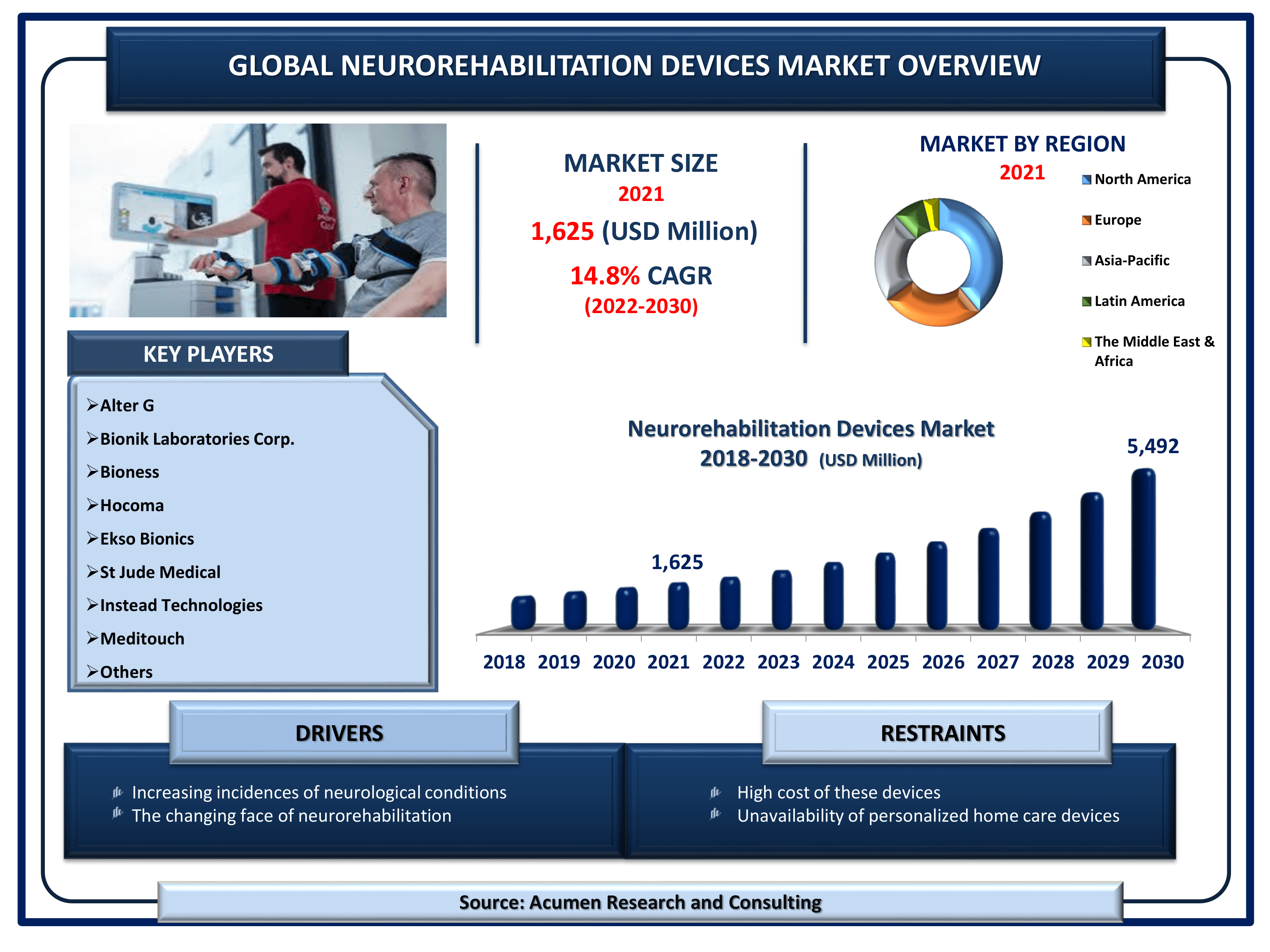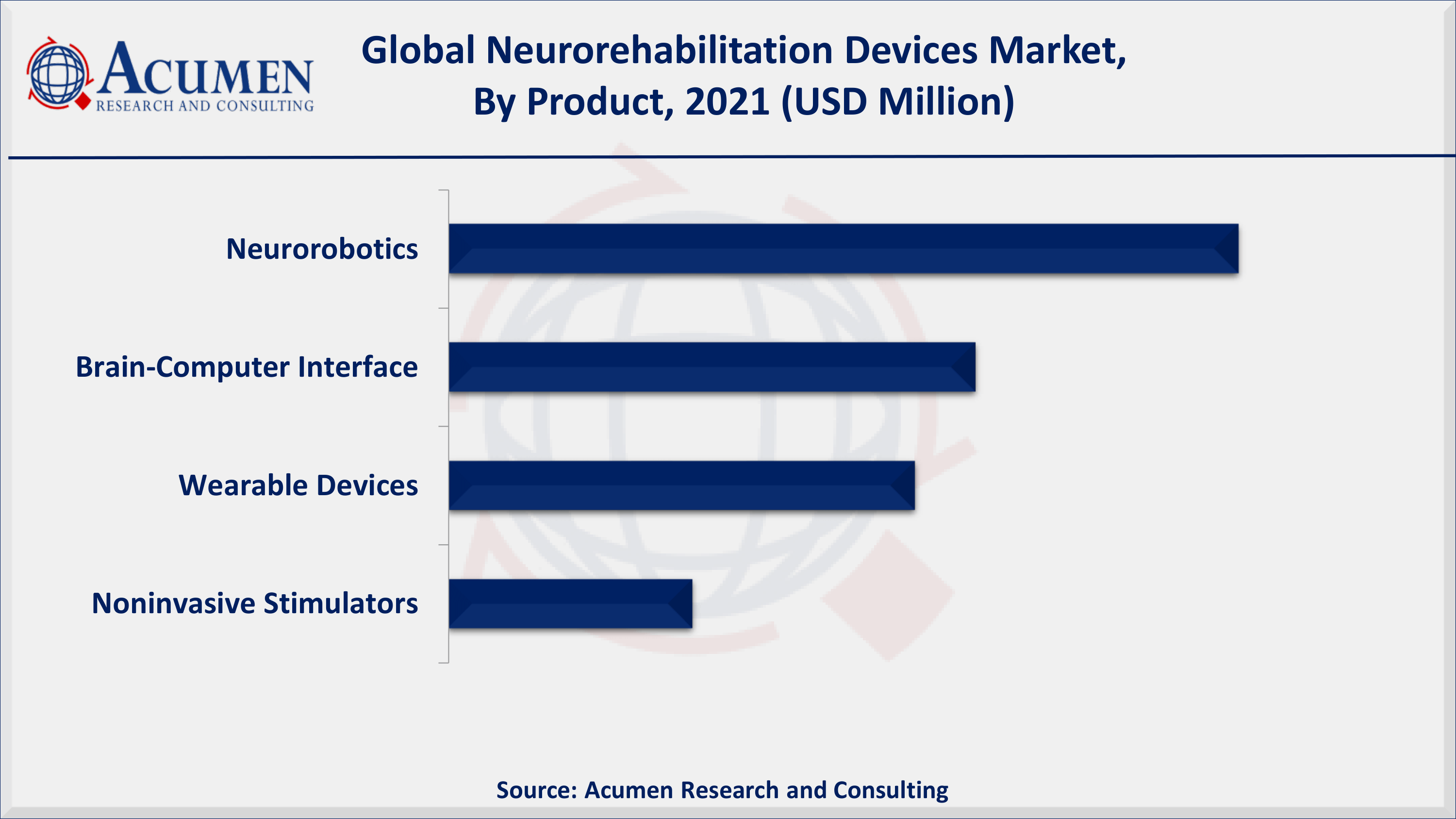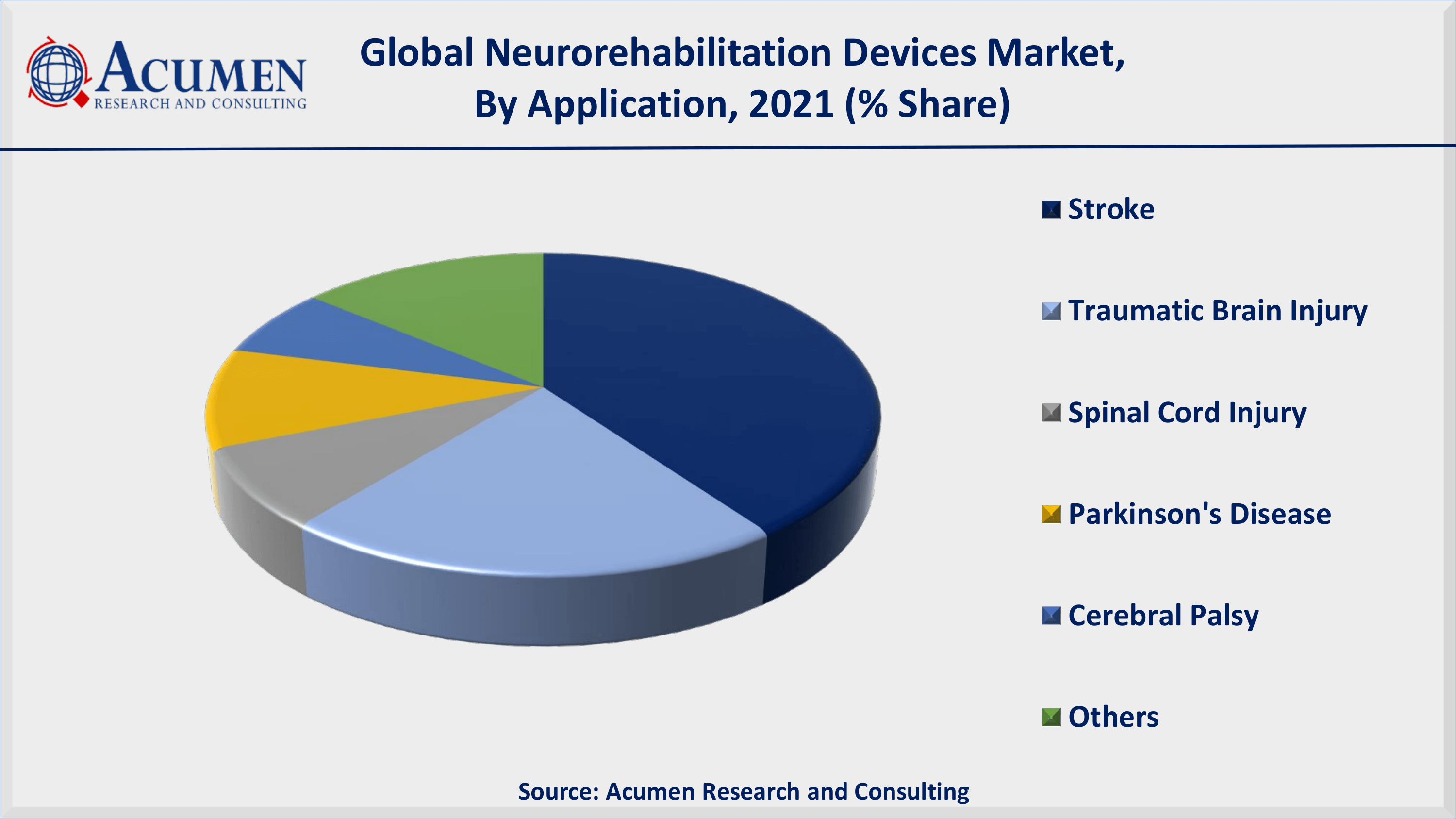March 2021
Neurorehabilitation Device Market Size accounted for USD 1,625 Million in 2021 and is estimated to achieve a market size of USD 5,492 Million By 2030 growing at a CAGR of 14.8% from 2022 to 2030.
The Global Neurorehabilitation Device Market Size accounted for USD 1,625 Million in 2021 and is estimated to achieve a market size of USD 5,492 Million By 2030 growing at a CAGR of 14.8% from 2022 to 2030. The increasing prevalence of neurological disorders such as multiple sclerosis, stroke, brain injuries, and cerebral palsy are fueling the neurorehabilitation device market growth during the forecast period 2022 to 2030. According to the Pan American Health Organization (PAHO), there were more than 533,172 deaths due to neurological conditions in 2019. In addition to that, in 2018, stroke accounted for about 1 of every 19 deaths in the US according to the American Heart Organization. Furthermore, the Stroke Association UK claimed that a stroke strikes every five minutes and 100,000 people have strokes each year in the UK.

Neurorehabilitation Device Market Report Key Highlights
A neurorehabilitation device is a modern technology that uses brain examinations related to neuroplasticity processes. The neuro rehab programs are done on an inpatient or outpatient basis. Manu skilled physicians are a part of the neurological rehab team that involves physiatrists, neurologists, rehab specialists, and among others. According to the IEEE, patient participation is the most important factor for rehabilitating the neural system after injury or stroke. Research conducted by the IEEE proves vital for patients suffering from stroke or injury. The research is conducted for developing a new method for re-connecting the brain to the limbs of the patient. Steady-state visual evoked potential (SSVEP) signals are read and decoded to extract the user's intent and are then fully controlled by a robot exoskeleton to move the patient's limb for therapy. Such artificial reconnection of the brain to limbs will result in improved outcomes.
Global Neurorehabilitation Device Market Dynamics
Market Drivers
Market Restraints
Market Opportunities
Neurorehabilitation Device Market Report Coverage
| Market | Neurorehabilitation Device Market |
| Neurorehabilitation Device Market Size 2021 | USD 1,625 Million |
| Neurorehabilitation Device Market Forecast 2030 | USD 5,492 Million |
| Neurorehabilitation Device Market CAGR During 2022 - 2030 | 14.8% |
| Neurorehabilitation Device Market Analysis Period | 2018 - 2030 |
| Neurorehabilitation Device Market Base Year | 2021 |
| Neurorehabilitation Device Market Forecast Data | 2022 - 2030 |
| Segments Covered | By Product, By Application, And By Geography |
| Neurorehabilitation Device Market Regional Scope | North America, Europe, Asia Pacific, Latin America, and Middle East & Africa |
| Key Companies Profiled | Alter G, Bionik Laboratories Corp., Bioness, Hocoma, Ekso Bionics, St Jude Medical, Instead Technologies, Meditouch, Touch Bionics, Kinova Robotics, and others. |
| Report Coverage |
Market Trends, Drivers, Restraints, Competitive Analysis, Player Profiling, Regulation Analysis |
Neurorehabilitation Device Market Insights
Rising prevalence of neurological disorders resulting in patients suffering from movement disabilities
According to the Institute for Health Metrics and Evaluation (IHME), globally in 2016, neurological disorders were the leading cause of disability-adjusted life years (DALYs) which is 276 million and constitutes 95% and the second leading cause of death is 9.0 million. The absolute number of deaths and DALYs from all neurological disorders combined increased deaths by 39% and DALYs by 15%. The only neurological disorders that had a decrease in rates and an absolute number of deaths and DALYs are tetanus, meningitis, and encephalitis. The fourth largest contributor of neurological DALYs was a stroke which constitutes 42.2% migraine 16.3%Alzheimer's and other dementias 10.4%, and meningitis 7.9%. Worldwide, the burden of neurological disorders will continue to increase. As the population is growing and aging the prevalence of major disabling neurological disorders steeply increases with age. Government has to face increasing demand for treatment, rehabilitation, and support services for neurological disorders. This treatment option is a progressive and modern method to tackle that renders functional restoration in patients suffering from movement disabilities. The service aims primarily to offer patients the optimum environment and perform daily activities at ease.
The changing face of neurorehabilitation
Exploration of the effects of neurorehabilitation technologies and the National Institute of Biological Sciences (NIBS) on plasticity through the usage of advanced technologies that involve functional MRI, near-infrared spectroscopy, high-density electroencephalogram (EEG), represents surrogate outcome measure in the future. According to the EurekAlert, on April 2020, a developed system for switching the activity of genes could improve treatment for a broad range of neurological diseases. The team of researchers in viral neuroengineering at the Princeton Neuroscience Institute is developing genetic switches for use in gene therapy that is best practice suited for delivering new genes to replace or assist ones that are faulty. Gene therapy is a promising strategy for many diseases involving disorders that involve the brain such as Parkinson's disease and Alzheimer's disease.
Favorable reimbursement policies
Government and other third-party coverage and reimbursement policies largely determine neurorehabilitation services for the patient. Scientific evidence assist to determine which interventions are efficacious in clinical practice and which are effective in the community. Similarly, which service will receive reimbursement ultimately determines what service will be delivered. In the US, access to neurorehabilitation services is influenced by insurance coverage as well as geographic variation in the availability of services. Outside of Europe and the US, coverage, and access to neurorehabilitation is highly variable.
Neurorehabilitation Device Market Segmentation
The worldwide neurorehabilitation device market is split based on product, application, and geography.
Neurorehabilitation Device Market By Product

According to our neurorehabilitation devices industry analysis, neurorobotics accounted for a majority of the share in 2021. Neurorobotics is normally referred to as the study of the nervous system in connection with technology. The field of neurorobotics is the brain and its direct interaction with computer systems as well as methods of externally stimulating the brain. Advancements in the field of exoskeletons and prosthetics are acting as a major drivers for neurorobotics. The exoskeleton provides body support to physically disabled and traumatized patients. Further, Saebo, Inc., Hocoma AG, and Bioness Inc. are some of the prominent manufacturers of exoskeletons and prosthetics. Such systems are expected to generate larger revenues due to high availability in combination with rising investments by manufacturers to develop novel systems and platforms.
Neurorehabilitation Device Market By Application

According to our neurorehabilitation device market forecast, the stroke sub-segment generated significant revenue in 2021 and is likely to do so in the coming years. Almost 80% of stroke survivors have hemiparesis or weakness on one side of the body. When this happens, survivors are more likely to experience balance problems and walking problems (gait). Despite recent breakthroughs in reperfusion therapy, the majority of stroke patients will endure life-changing disabilities after the acute phase. Stroke care does not, therefore, end in the ICU, and neurorehabilitation is an important component on the long road to recovery. Poststroke rehabilitation is best given by a multidisciplinary team that includes doctors, nurses, therapists, and other healthcare specialists, as well as patients and their social networks.
Neurorehabilitation Device Market Regional Outlook
North America
Europe
Latin America
Asia-Pacific
The Middle East & Africa (MEA)
Neurological Conditions Cause 47.4 Deaths per 100,000 Populations in the United States
North America is anticipated to hold significant neurorehabilitation devices market share in the forecast period. North America is projected to hold the largest market share in the global neurorehabilitation devices market owing to the high prevalence of Alzheimer's and Parkinson's disease, rising geriatric population, and technological advancements in this region. Additionally, rising awareness of the benefits of neurorehabilitation devices and the presence of well-established healthcare infrastructure fuels the overall regional growth of the North American region. The neurorehabilitation devices market is fuelled by a growing aging population that subsequently raises Parkinson's disease and Alzheimer's disease. Therefore, surging cases of neurological conditions essentially pave the way for the increased growth and adoption of neurorehabilitation devices in the coming years. Healthcare companies are focusing on the advantages associated with virtual reality (VR) as there is a short window when the brain can bounce back in the early stages of treatment. Hence, VR and neuroscience contribute fullest to maximizing the potential for full recovery of the patient. Companies are interested to increase the availability of VR devices in hospitals and clinics.
Asia-Pacific Will Move At a Fast Pace in the Neurorehabilitation Devices Market
China's neurorehabilitation devices market will grow lucratively due to the rising number of stroke incidences. In China, stroke is the leading cause of disability, and annually around 2,000,000 people suffered from a stroke. An aging population coupled with a high prevalence of neurological diseases will propel the Chinese neuro-rehabilitation devices market growth in the forecast period. Moreover, rising public awareness and investments in healthcare drive the Asia-Pacific regional market for neurorehabilitation devices. For instance, Switzerland-based Hocoma AG has entered Indian markets by associating with Apollo Hospitals to offer neurorehabilitation services to the patient base in India.
Neurorehabilitation Device Market Players
Some of the top neurorehabilitation device companies offered in the professional report include Alter G, Bionik Laboratories Corp., Bioness, Hocoma, Ekso Bionics, St Jude Medical, Instead Technologies, Meditouch, Touch Bionics, Kinova Robotics.
Looking for discounts, bulk pricing, or custom solutions? Contact us today at sales@acumenresearchandconsulting.com
March 2021
July 2024
August 2024
January 2018